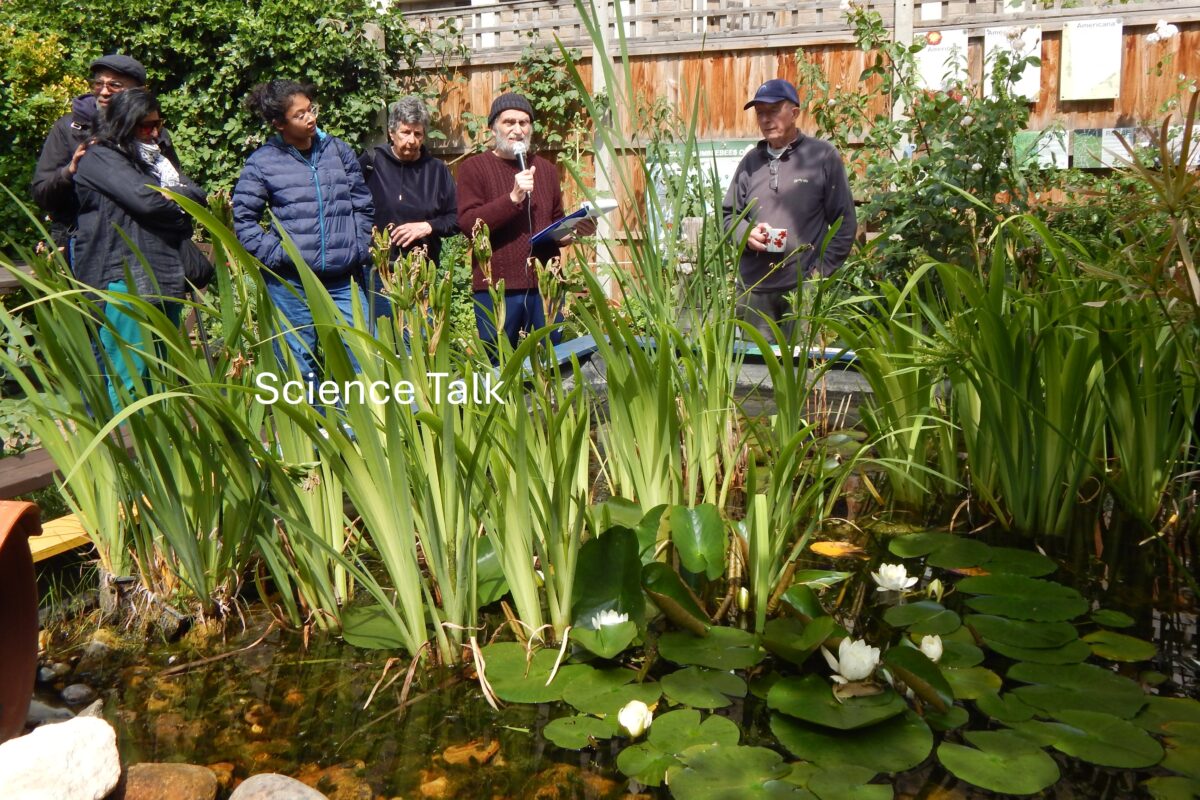On Saturday we had a very successful plant sale in spite of the rain, 2 cm in the last two days as measured by our new rain gauge. Underleaf donated plants for the sale, a van full which I helped to unload on Friday. They supply plants to businesses and for events, and had a lot over. We were certainly grateful, and those who come to the sale got some real bargains.
I gave the third Sunday Social Talk in the garden today. The theme was science in the garden. I began with an introduction in the shelter, explaining why it was warmer inside the shelter than outside during the day. It’s because the warm air, heated by the sun, rises, and would mix with cold air and sink, but the roof stops the mixing, and so the space heats up.
After the introduction, we took a walk round the garden. I took along a microphone, with an amplifier on a trolley. It is important to be heard, especially in outside spaces. This is the route we took: from the shelter to the silver birch, to the greenhouse, to the compost heaps, to the pond, to the sycamore tree, to the plants on the wall, to the walnut tree, to the cherry trees, to the metre cube by the pergola, and back to the shelter. At each stage giving some science.
We stopped at the compost heaps, where plant material is broken down to compost by the action of microbes utilising air and water, with nitrogen a necessary ingredient. It is a complex subject, and I shall devote a future blog to it.
Photosynthesis came up several times:
CO2 + H2O + sunlight, with chlorophyll as a catalyst, gives: Glucose + Oxygen
The underwater plants in the pond give up their oxygen to the water. It is needed by the animal life: tadpoles, damselfly larvae, backswimmers, daphnia etc. Of late, the pond has become murky with an algae bloom which has meant the oxygenators have had less sunlight, so have given off less oxygen. We have put in a pump to bubble air through. This seems to have helped as the pond water has cleared somewhat. But there are multiple factors at play, so whether it is the pump that has clarified the pond, one can’t be sure.
At the sycamore tree, I took one of its large leaves, like a flat green glove, to demonstrate its utility. Leaves are often called plant factories. They are full of chlorophyll, hence the greenness, with tiny holes to allow carbon dioxide to enter, water comes up from the roots, and sunlight gets the photosynthesis going. The glucose created is the energy source for growth and for making flowers and seeds.
Air is 21% oxygen. It is continually created by plants, as oxygen is used up all the time. By burning (of fossil fuels and fires), by forming oxides (rust, verdigris etc) and breathed in by all animals. Trees help replenish oxygen but also store carbon in their heartwood, having taken carbon dioxide out of the air. It is why planting trees is so important in the battle against climate change.
We looked at the plants on the old wall by the mid gate. Coming out of the crumbling brickwork is purple toadflax, valerian, and moss. The moss is small but the other two are surprisingly large. The wall is old and its crumbling cement and brick enables the plant to root. The bricks are made of clay, which has some nutrients. Nitrogen is supplied by rotting former plants and possibly by bird droppings.
We looked at the walnut tree by the buddleia. It has about six walnuts which will be a record. I have only ever seen one before. The trees we looked at have mechanisms for avoiding self fertilization which leads to weaker offspring as well as the increased likelihood of genetic diseases. The walnut does it by having the female catkins coming after the males have died, so must get pollen from elsewhere if they are to set seeds. The sycamore and silver birch have a different way. The stigmas, the female part, reject pollen from the same tree, so must be fertilized by pollen from another tree. Both trees are common, so there’s plenty of pollen around in the season, as hay fever sufferers know only too well.
After our tour of the garden, examining some of its science, we returned to the shelter. There I spoke of adjusting to climate change in the garden, with a tap at times of drought and more shade, as well as doing what we can to fight it by creating less waste, growing trees and other plants to soak up some of the carbon dioxide, the prime greenhouse gas.
We finished with tea and cake.


Comments 1
It was a fascinating talk, and useful to have this blog as a recap. Thank you.